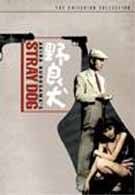Stray Dog is a forgotten classic if their ever was one. How an Akira Kurosawa noir has escaped my attention for so long is a complete mystery to me, no pun intended. I’m a complete Kurosawa junkie, from the epic Ran, to the soulful Ikuri, to the beautiful Dreams, to the completely kick ass Yojimbo, I can’t get enough. Stray Dog is yet another masterwork, a soulful tone poem about crime, morality, and life in postwar Japan. The Film focuses on Murakami a young rookie played by the great Toshiro Mifune . On a sweltering day in Tokyo he loses his gun to a pickpocket on a crowded bus, and goes to search Tokyo’s underworld for it. A sort of twisted take on the neo-realist classic The Bicycle Thief. He drifts through the Tokyo ghettos amid hustlers, petty thieves, hobos, and yakuza, all the stray dogs of the title desperately foraging to survive in postwar Tokyo. Posing as a down and out veteran Murakami descends into this world, the irony being that he really is a veteran and came very close to being down and out. As he tracks the gun down with the help of his older mentor they find it being used in robberies and murders. Eventually they realize that their quarry is not unlike Murakami, another veteran of the same age who went to war and came back with nothing but horrible memories and the stink of defeat. It’s about a man chasing his own dark doppelganger, both his own inner darkness, and the person he might have become if chance had been a little different. If that’s not high drama I don’t know what is (No Smartass remarks now).
As always Akira Kurosawa’s direction is of the absolutely highest order. This is one of the great atmospheric films. It takes place during a sweltering couple of Tokyo days and you can feel the heat baking down on you. Kurosawa also knew how to make great use of reality. Like Carol Reed’s The Third Man did in Vienna and The Bicycle Thief did in Italy, Kurasawa took Stray Dog’s cameras to the streets capturing real documentary footage of the world he saw around him, and the pain and suffering of everyday postwar Tokyo. The scene where Murakami first goes under cover to look for the gun is amazing, lasting 10 minutes and bristling with authenticity and quiet contemplation. For anyone who like Ghost and the Shell, Stray Dog’s fingerprints are all over it.
The film is startling in its humanism. Completely inverse to the pessimism of its sister films The Third Man and The Bicycle Thief, Kurosawa views humanity as an ultimate good. These lead to several scenes that are sweet but never sappy, such as when a female pickpocket that Murakami has followed buys him a beer and they stop to admire the stars.
Mifune (Kurwosawa’s Robert DeNiro) as always is excellent, portraying Murakami as someone desperate to do the right thing, and his relationship with Sato played by fellow Kurosawa veteran, Takashi Shimura is quite touching.
Stray Dog is a great film period, an affecting character study, a crackling good film noir, high drama, and the first true masterpiece from one of the greatest cinematic minds of all time. Do you really need another reason to buy? The transfer is 16:9, and looks nice and sharp. The film can’t help but show its age a little but thanks to a new transfer this problem is minimal. The sound is also nice and sharp.
As for the actual extras, well I can’t help but be a little disappointed, I mean come on this is a Criterion disc isn’t it? Where are all the great extra’s? Shouldn’t this be stuffed to the gills? The first extra is a short half hour documentary entitled “It Is Wonderful To Create: Stray Dog”. Although short, this little feature is jam packed with storyboards and interviews from people who, for a nice change of pace, all actually have something interesting and of value to say. Will wonders never cease?
The commentary has a little to be desired but it is informative and the commentator Stephen Prince, a Kurosawa biographer, has a true passion for the subject matter. Then again maybe it’s just that anything sounds good after being forced to sit through 3 hours of Richard Schenkle’s disinterested warbling on The Good The Bad and The Ugly commentary.
The final feature is the booklet which contains a chapter from Kurosawa’s autobiography on Stray Dog, which is written in levity and good humor and an essay by Terrence Rafferty which is written in fawning admiration. Both are interesting reads.
All in all the extra’s are high quality, but there are just so damn few of them, especially for a Criterion disc.

Dean Norris Explains The Breaking Bad Reunion That Convinced Him To Join Law And Order: Organized Crime: 'I Could Trust What Was Gonna Happen'

If Happy Gilmore 2 Is Actually Happening, Here Are 8 Things We Need To See

Fans Were Asked What The Most Rewatchable TV Show Is, And Two Choices Are Getting A Ton Of Love
Most Popular




